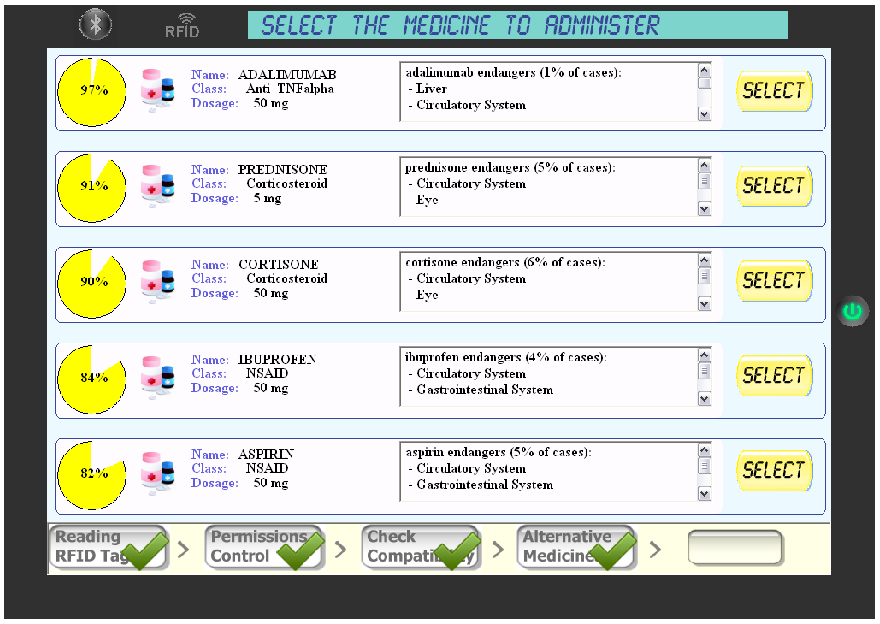Penetration of RFID (Radio Frequency IDentification) technology in the healthcare sector is increasing. RFID transponders (tags) can be attached to patients, equipment and staff in order to identify and track them within a hospital, by means of a network of RFID readers deployed in key locations. The integration of RFID into a Hospital Information System allows to: automate security (authorization enforcement) and safety (prevention of human error) checks during critical processes such as patient admission, checkout and medication administration; reduce response times in emergency situations; improve efficiency of resource allocation. Research studies and pilot projects have evaluated this impact in ordinary hospital activities [3] as well as in emergency conditions due to disasters [4] or epidemics [5].
Nevertheless, the adoption of RFID just for item identification does not provide adequate support to most knowledge-intensive medical tasks. Therefore we are developing an innovative Decision Support System (DSS) for healthcare professionals [1], based on a semantic enhancement of RFID standard protocols [6]. Semantically annotated descriptions of both medications and patient's case history are stored in RFID tags in a compressed format [7]. In the proposed approach, non-monotonic inference services presented in [8] are exploited to retrieve suitable treatments for a given disease taking into account the case history of the patient [2]. The DSS is able to calculate a score based on the semantic compatibility between diseases affecting the patient and characteristics of available medications. Context data-oriented parameters are combined with the semantic-based score by means a utility function, so allowing the DSS to:
- find possible inconsistencies in a proposed therapy;
- arrange best treatment options in relevance order;
- explain the matchmaking outcomes in both cases.
The caregiver interacts with the DSS through a graphical user interface, providing a clear and workflow-oriented view of therapy management tasks while hiding the complexity of the underlying logic-based formal languages. In Figure 1 the caregiver is granted access to the patient therapy management and she can see information extracted from RFID tags of both patient and medication. In Figure 2 she is alerted of potential adverse effects of a given therapy with respect to the particular patient's profile. Then she can asl for suggestions of other treatments: Figure 3 shows the outcome of the ranking of treatments modeled in the DSS Knowledge Base.
The DSS can be deployed in hospitals and rehabilitation centers, e.g. in smart bed, but it can also run stand-alone - without the need external connections - on RFID-enabled tablet devices. In the latter mode, it can be used in fully mobile and pervasive healthcare scenarios, such as ambulances, tele-medicine, tele-homecare and tele-rehabilitation.
Publications
Scientific publications about Kinect posture and gesture recognition
-
M. Ruta, F. Scioscia, E. Di Sciascio, C. Scioscia. A knowledge-based framework enabling decision support in RFID solutions for healthcare, in 2010 IEEE International Symposium on Industrial Electronics (ISIE). pp. 1983–1988, IEEE, 2010.
-
M. Ruta, F. Scioscia, T. Di Noia, E. Di Sciascio. RFID-based semantic-enhanced ubiquitous decision support system for healthcare, in 3rd International Workshop on RFID Technology - Concepts, Applications, Challenges (IWRT 2009), pp. 79-88 - 2009.
References
-
R. Sangwan, R. Qiu, D. Jessen. . International Journal on Using RFID tags for tracking patients, charts and medical equipment within an integrated health delivery network, in Proceedings of Networking, Sensing and Control, pp. 1070–1074, IEEE, 2005.
-
E. Fry, L. Lenert. MASCAL: RFID Tracking of Patients, Staff and Equipment to Enhance Hospital Response to Mass Casualty Events, in AMIA Annual Symposium Proceedings 2005, pp. 261-265, American Medical Informatics Association, 2005.
-
S. Wang, W. Chen, C. Ong, L. Liu, Y. Chuang. RFID Application in Hospitals: A Case Study on Demonstration RFID Project in a Taiwan Hospital, in Proceedings of the 39th Annual Hawaii International Conference on System Sciences (HICSS’06), Vol. 8, pp. 184-193, 2006.
-
T. Di Noia, E. Di Sciascio, F. Donini, M. Ruta, F. Scioscia, E. Tinelli. Semantic-based Bluetooth-RFID interaction for advanced resource discovery in pervasive contexts , International Journal on Semantic Web and Information Systems (IJSWIS), Vol. 4, No. 1, pp. 50–74, 2008.
-
F. Scioscia, M. Ruta. Building a Semantic Web of Things: issues and perspectives in information compression , Semantic Web Information Management (SWIM'09), in Proceedings of the 3rd IEEE International Conference on Semantic Computing (ICSC 2009), pp. 589-594, IEEE, 2009.
-
S. Colucci, T. Di Noia, A. Pinto, A. Ragone, M. Ruta, E. Tinelli. A Non-Monotonic Approach to Semantic Matchmaking and Request Refinement in E-Marketplaces , International Journal of Electronic Commerce, Vol. 12, No. 2, pp. 127-154, 2007.





